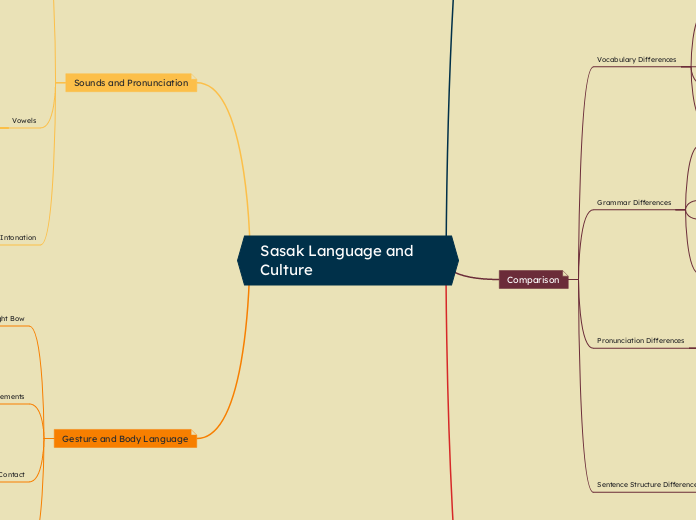Sasak Language and Culture
Words and Phrases
Introduction
Sai arande? (what's your name?/Siapa nama kamu?)
aran tiang (my name is/nama saya adalah)
tiang lekang ... (i am from .../saya dari ....)
Fruits
Kelendeh (watermelon/ semangka)
Duren (Durian)
Gedang (Papaya)
Pao (mango/mangga)
Puntik (banana/pisang)
organs
ime (hand/tangan)
kento (ears/telinga)
sangkep (cheeks/pipi)
otak (head/kepala)
Daily Life
Amak (Bapak/Mr)
Ina (Ibu/Ms)
Tiang demen daran .... (i like to eat .../saya suka makan ...)
pire ajin .... iki, amak/ina? (How much is this ..., Mr/Ms? / berapa harga ... ini, bapak/ibu?)
Hatur tampiasin (Thank you/terima kasih)
Basics
Tiang (me/saya)
Side (you/kamu)
tegel (hold/pegang
nine (girl/perempuan)
mane (boy/laki-laki
Comparison
Vocabulary Differences
Sasak Language:
Unique Words: Sasak contains unique lexicons that might not have direct translations in other languages. For example, "nyong" means "I" or "me," distinct from more common pronouns found in other languages.
Home/School Language (e.g., Indonesian):
Unique Words: Indonesian has words like "kamu" (you) which are used routinely and differ significantly from the Sasak pronouns.
Grammar Differences
Sasak Language:
Verb Focus: Sasak grammar often uses verb prefixes to indicate nuances in mood or aspect, which might not be present in other languages. For example, adding "ber-" to a root word can change its meaning to an ongoing action.
Home/School Language (e.g., Indonesian):
Noun Phrases: Indonesian grammar often emphasizes noun phrases and uses a set of prefixes and suffixes that alter the meaning of the root nouns, such as "ke-" for directional purposes or "peng-" to indicate an agent doing the action.
Pronunciation Differences
Sasak Language:
Consonant Pronunciation: Sasak has distinct pronunciations for certain consonants; for example, the 'c' is pronounced as a 'ch' sound.
Home/School Language (e.g., English):
Vowel Sounds: English contains a wider range of vowel sounds and diphthongs that do not exist in Sasak, making pronunciation particularly challenging for learners.
Sentence Structure Differences
Sasak Language:
Verb-Subject-Object (VSO): In many sentences, the verb comes first, followed by the subject and then the object, which is quite different from the typical SVO (Subject-Verb-Object) order in many Western languages.
Example: "Mangan aku ikan" (Eat I fish).
Home/School Language (e.g., English):
Subject-Verb-Object (SVO): English predominantly uses the SVO order.
Example: "I eat fish."
Cultural Reflection
Daily Life
Word: Nggenti (to wait)
Cultural Aspect: Reflects the communal and patient nature of Sasak culture, where taking time and waiting are integral to daily interactions.
Word: Beteng (a type of traditional cloth)
Cultural Aspect: Indicates the importance of traditional attire in daily life, often worn during ceremonies or special occasions.
Customs
Phrase: Merarik (marriage)
Cultural Aspect: Represents the traditional marriage custom of the Sasak people, including practices like "nyolong" (the groom 'kidnapping' the bride as a sign of intention to marry).
Word: Besiru (collaboration)
Cultural Aspect: Reflects the communal spirit in Sasak society, where collaboration in farming, building houses, or community activities is valued.
Cultural Practices
Word: Bau Nyale (sea worm festival)
Cultural Aspect: Refers to the annual festival where Sasak people gather to catch sea worms, believed to be the reincarnation of a legendary princess. The festival celebrates prosperity and is an important cultural event.
Phrase: Selaparang (traditional kingdom)
Cultural Aspect: Highlights the historical heritage of the Sasak people, connecting the language to their ancient kingdoms and the pride in their ancestry.
Sounds and Pronunciation
Consonants
Nasal 'ng'
IPA: /ŋ/
Example: Like the 'ng' in English "singing."
Sasak Example: In the word "bengong" (to stare), pronounced /bə.ŋoŋ/.
Retroflex 'ny'
IPA: /ɲ/
Example: Similar to the Spanish 'ñ' as in "niño."
Sasak Example: "nyong" (I/me), pronounced /ɲoŋ/.
Voiceless palatal stop
IPA: /c/
Example: Similar to the 'ch' in English "check."
Sasak Example: "cicing" (sit), pronounced /tʃi.tʃiŋ/.
Vowels
Open back unrounded vowel
IPA: /ɑ/
Example: Similar to the 'a' in "father."
Sasak Example: "batok" (back), pronounced /bɑ.tok/.
Close front unrounded vowel
IPA: /i/
Example: Similar to the 'ee' in English "see."
Sasak Example: "birin" (rice), pronounced /bi.rin/.
Stress and Intonation
Stress patterns: Sasak typically stresses the final syllable in words.
Example: In "bengong," the stress is on the final syllable: /bə.ŋóŋ/.
Gesture and Body Language
Nodding and Slight Bow
Description: A gentle nod combined with a slight bow of the head is commonly used as a sign of respect or agreement.
Significance: This gesture is particularly important in formal settings or when addressing elders, signaling deference and acknowledgment.
Hand Movements
Description: Open palm gestures with a slow movement from the speaker towards the listener during explanations.
Significance: These gestures are used to emphasize points or instructions, helping to convey clarity and importance.
Eye Contact
Description: Moderated eye contact, where prolonged staring is avoided, especially with superiors or elders.
Significance: This behavior respects personal space and authority, maintaining a balance between engagement and politeness.
Touch
Description: Light touches on the arm or shoulder during conversations among peers or friends.
Significance: Touch is used to express solidarity and comfort, indicating closeness and camaraderie in more informal settings.
